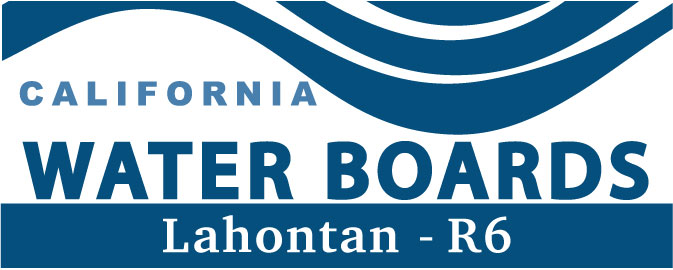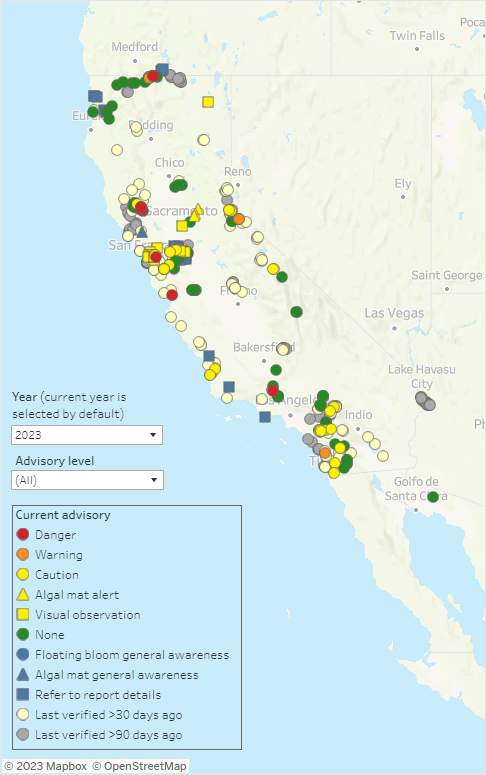Harmful Algal Bloom (HABs)
See an algae bloom?
Freshwater and Estuarine Harmful Algal Bloom Program
Harmful algal blooms (HABs) are a progressing and critical issue because their presence in surface waters may threaten many of the beneficial uses of water (e.g. recreation including swimming and fishing, cold freshwater habitat, domestic and municipal supply) that the public enjoys. Over the past decade, severe blooms have impacted drinking water systems across the state including the State Water Project, which delivers clean water to 27 million Californians, 750,000 acres of farmland, and businesses throughout our state (State Water Project June 2023). HABs have been identified in lakes, rivers, and streams in all parts of the state, and have caused illness in humans, pets, livestock, and wildlife. Since the Water Boards began tracking HABs in 2016, the number of HAB incident reports submitted by the public, Water Board staff, and local agencies annually has increased sixfold. The negative effects of HABs are wide-reaching and can degrade nearly all beneficial uses that the Water Board aims to protect for the people of California.
With the Freshwater and Estuarine Harmful Algal Bloom Program Bill (Assembly Bill 834) being approved by the governor in 2019, an official program to study, track, and inform the public about HABs was established. The Program aims to protect water quality and public health from harmful algal blooms. The bill also requires the coordination of immediate and long-term algal bloom event incident response, as provided, and conduct and support algal bloom field assessment and ambient monitoring at the state, regional, watershed, and site-specific waterbody scales. For more in-depth information on how the Water Boards are implementing AB 834 visit the State FHAB website.
For more information about HABs please visit the State HAB Portal.
Lahontan Regional Efforts
Within the Lahontan Region we have a dedicated HAB coordinator and support staff working to implement mandates outlined in Assembly Bill 834. Over the next few years, Region 6 aims to focus on (1) collaboration with partner entities to build an efficient region wide HAB response and monitoring program, (2) pre-holiday assessments of popular waterbodies in order to inform the public of areas where HABs are occurring during high-use holiday periods, and (3) special studies to help further our understanding of HABs. This is in line with implementing the 2021 HAB Monitoring Strategy and Framework.
We want to recognize our regional partners since our program would not be as far reaching throughout the Lahontan region without their involvement. The Lahontan region roughly spans from the Oregon boarder down to Victorville encompassing everything East of the Sierra Nevada Mountain Range. We rely on our partners to help us to quickly reach areas farther from our South Lake Tahoe and Victorville Offices. Our partners include Lassen National Forest, Eagle Lake Guardians, Truckee River Watershed Council, Nevada County Environmental Health Department, Tahoe National Forest, Tahoe Keys Property Owners Association, League to Save Lake Tahoe, California State Parks, California Tahoe Conservancy, City of South Lake Tahoe, Tahoe Paradise Park, Lake Tahoe Basin Management Unit, El Dorado County Environmental Health Department, Alpine Watershed Group, South Tahoe Public Utility District, California Department of Fish and Wildlife, Alpine County Environmental Health Department, Nevada Department of Environmental Protection, Walker River Irrigation District, Friends of Inyo, Mono County Environmental Health Department, Inyo County Environmental Department, Los Angeles Department of Water and Power, Green Valley Lake Recreation, Arrowhead Lake Association, San Bernardino County Parks, and San Bernardino Environmental Health Department.
Other Resources
- How to protect yourself from a HAB
- Frequently asked questions for Human Health in Recreational Waters
- Visual identification of a potential HAB
- Dog Impacts
- State HAB Mitigation Resources
- Interstate Technology Regulatory Council (ITRC) HAB Management and Control Strategies
- Detailed look at HAB incidents in Tahoe and the Tahoe Keys using a StoryMap in English and Spanish
- Detailed explanation of StoryMap concepts including advisory signs and monitoring within Lake Tahoe and the Tahoe Keys
- Fact sheet about β-Methylamino-L-alanine (BMAA)
Questions or Comments about HABs in the Lahontan Region?
Please email Sabrina Rice at: sabrina.rice@waterboards.ca.gov




